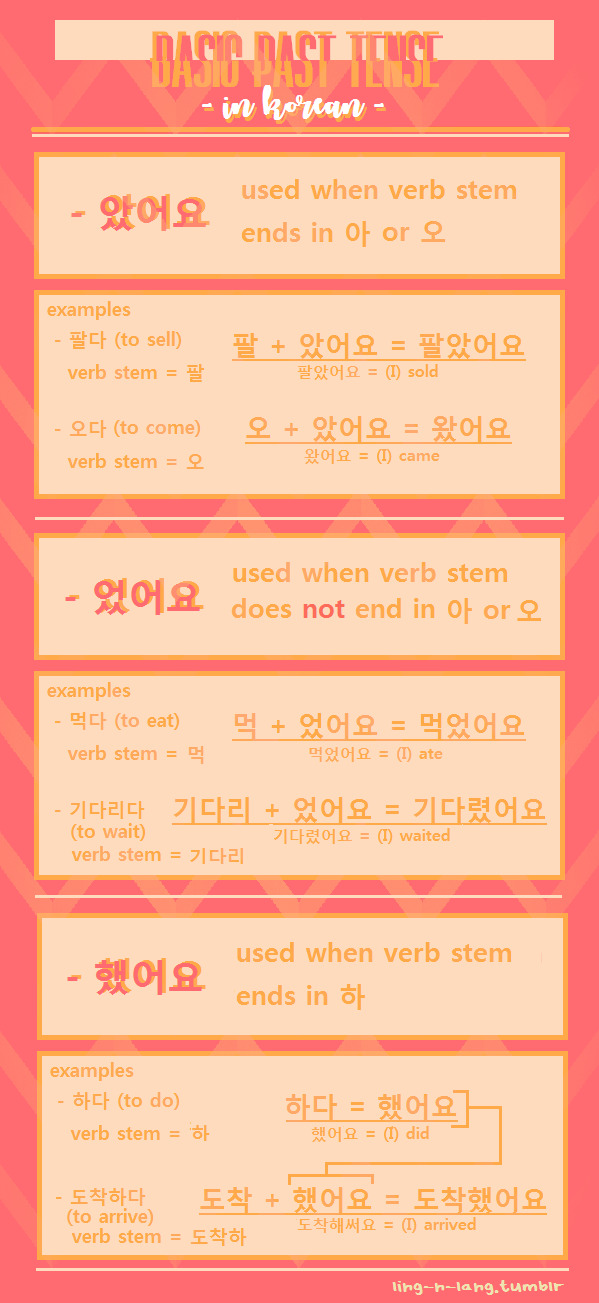안녕!! 엘입니다! hi, i'm el!! · korean studyblr · not fluent ・ japanese studyblr @mxnojun
Don't wanna be here? Send us removal request.
Photo
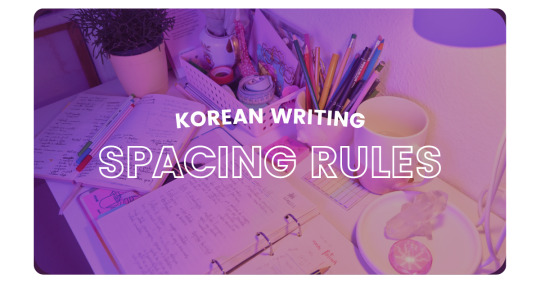
Writing in Korean can be quite complex when it comes to spacing (띄어쓰기), as it involves several factors like grammar, sentence structure, and even the type of words. In this article, I’ll share some of the most important rules I’ve learned with you.
1. Particles:
Korean uses particles to indicate grammatical relationships between words in a sentence. To ensure clarity, it is essential to separate these particles from the following words. Some commonly used particles in Korean include 은/는, 이/가, 을/를, 에, 에서, (으)로, 에게, 도, 와/과, and so on.
For example, in the sentence “저는 한국에서 떡볶이를 먹었습니다” (I ate Tteokbokki in Korea), there are three particles used: 는, 에서, and 를. To make it clear, it is essential to add spaces after each particle.
It is essential to note that particles are included as part of the preceding word. Therefore, particles are not standalone words and should be attached to the word they modify without spaces.
2. Independent Nouns:
In some sentences, there may be two or three nouns put together to form a noun phrase. In constructing such phrases, it is generally advisable to separate each independent noun with a space.
For example, “한국 음식” (Korean Food) and “경영 대학교” (Business University) both consist of multiple nouns that should be separated by spaces.
However, there are exceptions to this rule:
Compound Words: When words are combined to create a new meaning, they should be written without spaces. For example, “tear” in Korean is “눈물”, a compound word made up of 눈 (eyes) and 물 (water). This word should be written together as “눈물” without a space between them. The same applies to verbs such as “to visit,” which is “방문하다”, a compound word made up of “방문” (visit) and “하다” (to do).
Proper Nouns: If the noun phrase is a commonly used or official name, such “한국관광공사” (Korean Tourism Organization) or “국립중앙박물관” (National Museum of Korea), it is standard to write the entire phrase without spaces. Doing so makes it more easily recognizable as a specific entity or organization.
3. Person’s Name and Title
Korean personal names consist of a surname and a given name, both of which have independent meanings and can be used as separate words. Although it can be argued that they should be written separately, personal names are unique nouns, and Korean surnames are usually only one syllable, making them feel incomplete on their own. Therefore, it is customary to write personal names without spaces between the surname and given name.
For example, “Park Ji-min” is written as “박지민,” “Kim Min-seok” is “김민석,” and “Lee Min-ho” is “이민호,” all without spaces.
However, when titles or job names follow a personal name, they are separate units and should be written with a space between them.
For example: 박지민 씨 (Mr. Park Ji-min), 민수철 교수 (Professor Min Su-cheol), 김 의사님 (Doctor Kim) all have a space between the personal name and the title or job name.
4. Numbers and counters:
In Korean, spacing is used between every ten thousand when writing numbers. This means that if you have a number with five digits or more, you will use a space to separate the digits in groups of four.
For example:
이천이십삼 (2023)
구만 팔천칠백육십오 (98765)
일억 이천삼백사십오만 육천칠백팔십구 (123456789)
When it comes to combining numbers with counters, there are two cases to consider:
If you write the number in digits, there is no space between the number and the counter. For example, “1개” (one piece), “2번” (two times), and “3명” (three people) have no space between the number and the counter.
However, if you write the number in words, there should be a space between the written number and the counter. For example, “삼 학년” (third grade), “칠천 원” (seven thousand won), and “칠 개월” (seven months) have a space between the written number and the counter.
5. Word modifiers:
When a modifier (such as an adjective, verb, or adverb) modifies a word, it should be separated from the word by a space. This helps to clarify the relationship between the two words and make the sentence easier to read.
For example:
유나는 예쁜 여자여요 (Yuna is a pretty girl)
한국 와서 처음 먹은 음식 기억나요? (Do you remember the first food that you ate in Korea?)
저는 일을 잘 해요 (I do my job well)
All use spacing to separate the modifier from the word.
Additional Notes:
– It’s worth noting that there are certain grammatical structures in Korean that require specific spacing. For example, “(으)ㄴ 적이 있다” (have done in the past), “(으)ㄹ 수 있다” (can/be able to), “아/어 보다” (try doing) and so on. It’s important to pay attention to these spacing rules when learning Korean to ensure that your writing is accurate and clear.
– Finally, when using “이다” (to be) or “아니다” (to not be), it’s important to note that “이다” is written immediately after a noun, while “아니다” is written separately from the noun due to the particle. This is important to keep in mind when writing sentences that use these verbs.
For example:
학생입니다 (I’m a student)
학생이 아닙니다 (I’m not a student.)
The preceding explanation outlines my current understanding of the spacing rules when writing in Korean. However, I also want to point out that there might be some special cases or exceptions to these rules that I’m not aware of. So, if you have any experience with these special cases, I’d love to hear about it! Let’s share our knowledge and learn from each other.
🌸 🌼 🌻
Support me at: https://koreanlanguageloving.my.canva.site/
129 notes
·
View notes
Text
hottest language learning tip
write a diary
literally
just write a diary, it has helped me sooo much and i dare say it has been the most developing thing i’ve done while learning french, nothing else compares
1. you’re exposed to the language daily
2. you quickly see which words are missing from your vocabulary
3. you learn to write about the things you think about a lot
4. learning to actually think in your target language
5. having to look up words and when reading the entry back a couple of days later you can’t even remember which words you didn’t know
6. going back to the earlier entries and seeing all the mistakes and knowing how much better you’ve become
7. when you’ve been writing for a few months and your target language becomes a natural way for expressing yourself
8. when you’ve been writing for a few months and you start seeing the diary writing as a way of self-expression and stressrelief, and the language learning aspect becomes natural and secondary
9. filling out a whole book using only your target language and physically seeing how much you’ve accomplished
38K notes
·
View notes
Text

KOREAN FILLER WORDS
Um.. you know... like... well... I mean... 😅 I just can't get the words out It seems
Anyways In case you don't know what filler words are allow me to "fill" you in🤣
When you are trying to remember a word or remember what you were about to say you use filler words. In English for example, we use "Uhm" but actually in Korean they don't say "um" the way we do. A few more examples are "like" or "well" or "you know"
I included a few "sentence starters" in this post as well. Which basically means you can start a sentence with it or you can begin a conversation easily by using it.
"Honestly speaking, blah blah blah"
"Of course! blah blah blah"
"Anways... blah blah"
You get the Idea...
Sentence Starters & Filler Words:
음.. Umm
> more of a hmm sound than a strong uhm sound
어.. Uh..
그.. Uh..
저.. Well.. when thinking, hesitating
막 carelessly, recklessly
> similar to the filler word ‘like’
자! Ok!
> to get listeners’ attention in a speech
뭐지 - What was that..?, You know.. when you can’t think of something
뭐더라 - What was that..?, You know.. > when you can’t think of something
무슨 말을 하려고 했지? - what was I going to say?
뭐랄까.. How can I explain this..?
뭐라고? What? What did you say?
네? or 예? - Pardon? What did you say?
그게.. That is..
그러니까.. I mean..
그럼... (If that's the case) then...
그럼요 - of course
물론 - of course
물론이지 - of course
있잖아 - Hey, listen to this
> to draw attention
저기요 - Excuse me
> to draw attention of an unfamiliar person
에이~ Come on~ when you don’t believe what someone is saying
야 - Hey! , Hey you!
> can be rude not meant as a greeting
진짜 - really
정말 - really
맞아(요) right
네 - I see
그렇구나 - I see
그렇군요 - I see
오! - Oh!
아! - Ah!
우와! - Wow!
참! - Oh I just remembered!
아야! - Ouch!
글쎄.. or 글쎄요 - Well.., I'm not sure.., Let me see..
> can be another way to say "umm"
그래? or 그래요? Is that so?
설마 - No way
세상에 - Oh my god
말하자면 - in short
반면에 - on the other hand
아이고! - Oops!
어머나! - Oops!
어머! - Oops!
아무튼 - anyway
어쨌든 - anyway
그다지 - not really, not much
솔직히 - honestly
설직히 말하면 - speaking honestly, honestly speaking, to be frank, to be honest with you
왜? - what?
> can use when someone calls your name or tries to get your attention
왜냐하면 - because...
> you can use -거든요 at the end of the sentence whenever you pair it with 왜냐하면
오늘은 - today
> when your speaking your plans for today
지금은 - right now
> talking about something happening right now
If you want to say "I mean" or "I meant to say" there is not special word. simply pause for a second and start your sentence over (people will know)
140 notes
·
View notes
Text

august 25th- revision ideas!
hey everyone! i've been working on making more time for myself to do even little revision tasks, but i always have trouble thinking of ideas... so i created this little list :) i hope it helps you all to get stuck in to some revision and studying. feel free to ask questions or add ideas if you have any!
<3 melody
67 notes
·
View notes
Text

I […] you:
Love = 사랑해요;
Like = 좋아해요;
Hate = 미워해요;
Detest = 증오해요.
I feel / I am:
Angry = 화가나요;
Sad = 슬퍼요;
Happy = 기뻐요;
Merry = 즐거워요;
Excited = 신나요; (feeling excitation)
Depressed = 우울해요;
Afraid = 무서워요;
Nervous = 불안해요;
Thankful = 고마워요;
Sorry = 미안해요;
Puzzeled = 황당해요;
Confused = 당황스러워요;
Pleased = 만족스러워요;
Disappointed = 실망이예요;
Excited = 흥분되요; (feeling emotion)
surprised = 놀라워요;
Happy = 행복해요;
Unhappy = 불행해요;
Lonely = 고독해요;
Lonely = 외로워요;
Refreshed = 상쾌해요;
Unpleasant = 불쾌해요;
Comfortable = 편해요;
Falsely accused = 억울해요;
Shameful = 부끄러워요;
Ashamed = 창피해요;
Stuffy/difficulty in breathing = 답답해요;
Bored = 지루해요;
Painful = 아파요.
It’s…
Inconvenient = 불편해요;
Hard = 힘들어요;
Difficult = 어려워요;
Easy = 쉬워요;
Interesting = 재미있어요;
Mystic = 신비해요;
Charming = 매력적이예요;
Moving = 감동적이예요;
Admirable = 훌륭해요;
Stylish = 멋있어요;
Pretty = 예뻐요;
Beautiful = 아름다워요;
Cute = 귀여워요;
Complicated = 복잡해요;
Simple = 단순해요.
3K notes
·
View notes
Photo

1. 오다: to come 2. 마시다: to drink 3. 먹다: to eat 4. 주다: to give 5. 가다: to go 6. 듣다: to hear 7. 배우다: to learn 8. 만들다: to make 9. 앉다: to sit 10. 자다: to sleep 11. 씻다: to wash 12. 쓰다: to write 13. 울다: to cry 14. 갖다: to have 15. 웃다: to laugh 16. 보다: to see 17. 일어나다: to get up 18. 걷다: to walk 19. 춤추다: to dance 20. 만나다: to meet 21. 공부하다: to study 22. 운전하다: to drive 23. 사다: to buy 24. 읽다: to read 25. 주문하다: to order 26. 입다: to wear 27. 찍다: to take (picture) 28. 쓰다: to wear (hat, eyewear) 29. 신다: to wear (shoes, socks) 30. 빌리다: to borrow, lend 31. 전화하다: to telephone 32. 말하다: to talk, speak 33. 가르치다: to teach 34. 기다리다: to wait 35. 걸다: to call, dial 36. 청소하다: to clean 37. 타다: to ride 38. 나가다: to exit 39. 들어오다: to enter 40. 물어보다: to ask 41. 필요하다: to need 42. 도와주다: to help 43. 열다: to open 44. 닫다: to close 45. 일하다: to work 46. 쉬다: to rest 47. 운동하다: to exercise 48. 생각하다: to think 49. 알다: to know 50. 모르다: to not know 51. 요리하다: to cook 52. 끓이다: to boil 53. 썰다: to chop, slice 54. 튀기다: to deep fry 55. 재다: to measure, weigh 56. 섞다: to mix, blend 57. 굽다: to roast, grill, bake 58. 볶다: to fry 59. 급다: to grill 60. 휘젓다: to stir 61. 하다: to do 62. 있다: to have 63. 없다: to not have 64. 이야기하다: to talk, chat 65. 연습하다: to practice 66. 묻다: to ask 67. 내다: to pay 68. 살다: to live 69. 죽다: to die 70. 태어나다: to be born 71. 사랑하다: to love 72. 좋아하다: to like 73. 싫어하다: to hate, dislike 74. 결혼하다: to marry 75. 축하하다: to congratulate 76. 걱정하다: to worry 77. 약속하다: to promise 78. 거짓말하다: to lie 79. 고백하다: to confess 80. 찾다: to find, to look for 81. 준비하다; to prepare 82. 가지다: to have 83. 기억하다: to remember 84. 꿈꾸다: to dream 85. 시작하다: to start 86. 끝나다: to finish 87. 보내다: to send 88. 사용하다: to use 89. 팔다: to sell 90. 싸우다: to fight 91. 대답하다: to answer 92. 소개하다: to introduce 93. 출발하다: to depart 94. 도착하다: to arrive 95. 벗다: to undress, take off clothes 96. 이기다: to win, defeat 97. 지다: to lose, be defeated 98. 서두르다: to hurry, rush 99. 사랑에 빠지다: to fall in love 100.죄송하다: to be sorry.
(Instead of the 30 Korean verbs/adjectives I said to post, I prefer this “100 most useful korean verbs” by SydneytoSeoul)
7K notes
·
View notes
Text

KOREAN CONVERSATION PRACTICE
>karaoke<
⚠️this dialogue comes from the Naver Dictionary App. 📢Audio Is At The Very Bottom
THE DIALOGUE:
1: 우리 저녁을 먹고 뭐 할까요?
What shall we do after dinner?
2: 노래방에 가지 않을래요?
Why don't we go to a karaoke place?
1: 저는 노래를 잘 못 부르는데요.
I don’t sing very well.
2: 저도 못 불러요. 그냥 스트레스를 풀러 갑시다.
Neither do I. Let's go just to relieve our stress.
1: 이 근처에 노래방이 있어요?
Is there a karaoke place near here?
2: 시설이 좋아서 제가 자주 가는 노래방이 있는데 거기에 갑시다.
There is a karaoke place that I often go to because the facility is good. Let's go there
Grammar & Vocab Explained Below
📍-지 않을래요 = Why not..
1. This is used when making a suggestion to another person.
3. Roughly translates to “Wouldn’t you like to…?” -or- “Why not…?“
*This grammar form should only be used with verbs.
Examples:
같이 점심 먹지 않을래요?
Why don't we eat lunch together?
등산을 함께 가지 않을래요?
Would you not like to go hiking together?
📍잘 못 + V = "cannot do something well"
1. This used for talking about a skill or thing that you aren't very good at. It indicates a lack of skill.
2. It could translate to "I'm not good at..." or "I can't ... V"
Examples:
한국어를 잘못 해요.
I'm not good at Korean.
그림을 잘 못 그리다
I can't draw very well.
📍(으)러 가다(오다)= To Go V
1. Use to express the purpose of doing something
2. Translated as "To go do..." or "To go in order to..."
Examples:
도서관의 책을 읽으러 가요.
I’m going to the library to read books.
(For the purpose of reading books)
산책하러 공원에 갔어요.
I went to the park to take a walk.
📍ㅂ시다 = Let's
1. This grammar pattern is used to ask opinions and make suggestions
3. This is equivalent to saying "Let's (verb)" in English.
4. ㅂ시다 is equivalent to 자, but ㅂ시다 is formal
Examples:
비빔밥을 먹읍시다.
Let’s eat Bibimbap.
백화점에서 만납시다.
Let’s meet at the department store.
열심히 공부합시다.
Let’s study hard.
📓Vocabulary List📚
우리 = we
저녁 = dinner
먹다 = to eat
뭐 = what
노래방 = karaoke place
가다 = to go
저 = I
노래 = song
잘 = well
못 = can't
부르다 = to call, to sing
도 = also, too
그냥 = just
스트레스 풀다 = to relieve, get rid of stress
이 = this
근처 = in the vicinity, nearby
있다 = to exist
시설 facility, facilities
좋다 = to be good
자주 = often
거기 = there
Dialogue Audio
72 notes
·
View notes
Text
Vocabulary: Similar Words
안녕하세요!! Hey everyone! I have a fun vocab list for y’all today: it’s about Korean words that translate to the same thing in English, but are used differently! A lot of these words can be very confusing for learners (I often forget the differences between these words lol), so I thought it might be helpful to make a (pretty long but prob not exhaustive) list of these words and try to explain the differences!
Also, Talk to Me in Korean has a TON of videos explaining the differences between some of these words on their Q&A playlist, so I strongly recommend you check those out! I’ll also link some specific videos throughout my post since I cite them as a source! They also posted a video about how to distinguish between words that translate to the same thing in your native language a day after I started working on this lesson lol so be sure to check that out too! Let’s begin!!
이미 vs. 벌써: Already
These two mean the same thing! However, 벌써 is used to mean that something happened sooner than expected. For example: 와, 벌써 가을이네요! = Wow, it’s already fall! (as if the summer passed by really quickly and you’re surprised it’s already fall)
새 vs. 새로운: New
새 is used to describe something that is simply new and is the opposite of old: 제 오래된 컴퓨터가 고장 나서 새 컴퓨터를 샀어요. = My old computer broke, so I bought a new one.
새로운 (from 새롭다) refers to something that is new and fresh, like something never done or heard of before. TTMIK uses the example of the computer – if you were to say 새로운 컴퓨터, that might mean that Apple released a new Macbook or something – they created something new and never seen before.
파란색 vs. 푸른색: Blue
파란색 can describe anything that’s blue.
푸른색 can mean either blue or green because it’s usually used to describe things in nature: 푸른 하늘 means “blue sky,” while 푸른 숲 means “green forest,” for example.
기분 vs. 느낌: Feeling
기분 refers to emotions and moods: 기분이 좋아요. = I’m happy. (literally “I feel good,” but refers specifically to your emotions)
느낌 refers more to the atmosphere, or the kind of impression you get from something. Think vibes: 느낌이 이상해요. = I feel weird / It feels weird. (maybe you’re walking in an old abandoned house and you’re getting weird vibes)
걱정 vs. 고민: Worry
걱정 is closer to the English word for “worry”: 걱정하지 마! = Don’t worry!
고민 is closer to something like “concern” or “woes” or “troubles.” It refers to something a little more general, like something that weighs on your mind that you might want to talk to a friend about, while 걱정 gives a more anxious and immediate feeling: 고민을 털어놓다 = to get something off your chest
때무에 vs. 덕분에: Because of…
These two don’t really mean the exact same thing. 때문에 means “because of…”: (from Naver Dictionary) 너 때문에 내가 일에 집중이 안 돼. = I can’t focus on my work because of you.
덕분에, however, means “thanks to…” and is inherently more positive. I think 때문에 can be used positively too, but it can also be negative. 덕분에, on the other hand, is always positive: 우리 부모님 덕분에 대학교에 다니게 됐어요. = Thanks to my parents, I ended up going to college.
좋아하다 vs. 맘에 들다: To Like
좋아하다 just means “to like.” 맘에 들다 literally means “to come into one’s heart.” This is usually used when you see or experience something for the first time and you like it. For example, if you try on a dress in a store, you can say 맘에 들어요 to mean “I like it.” 좋아하다, on the other hand, can be used for stuff that you just like in general: 케이팝 좋아해요. = I like K-pop.
어렵다 vs. 힘들다: Difficult
어렵다 refers to something that is difficult, like a math problem or something: 이 수학 문제가 어려워요. = This math question is difficult.
힘들다 usually refers to a hard situation, like when you’re having a tough time doing something or going through a rough patch in your life. TTMIK’s video uses this sentence: 저 요즘 힘들어요. = I’m having a hard time these days.
힘들다 can also be used for things that are physically strenuous: 제 가방이 무거워서 들기가 힘들어요. = My bag is heavy, so it’s hard to carry.
On it’s own, the phrase 힘들어요 can also mean “I’m tired.”
추천하다 vs. 권하다: To Recommend
추천하다 is used to recommend things like books, songs, and movies. It’s a pretty general word: NCT의 신곡 추천해요. = I recommend NCT’s new song.
권하다 gives the feeling of strongly recommending something, or advising someone to do or not do something: (from Naver Dictionary) 교수는 나에게 유학을 권했다 = The professor advised[encouraged] me to study abroad.
권하다 could also be used when you’re offering something: 맥주를 권했어요. = I offered beer.
-고 싶다 vs. 원하다: To Want
-고 싶다 can be attached to verbs to mean “to want to [verb]”: 저 배고파서 먹고 싶어요. = I want to eat because I’m hungry.
갖고 싶다 can be used to mean that you want a noun – it literally means “to want to have”: 새 아이폰을 갖고 싶어요. = I want a new iPhone.
You really don’t hear 원하다 that much in regular spoken Korean. It’s more of a poetic word, hence why you hear it a lot in K-pop and stuff, such as in BTS’s “Blood Sweat and Tears”: 원해 많이 많이 = I want you a lot
밉다 vs. 미워하다 vs. 싫다 vs. 싫어하다: To Hate / To Dislike
밉다 and 미워하다 can only be used when talking about people: 그 사람 미워요. / 그 사람 미워해요. = I hate him.
싫다 and 싫어하다, however, can be used for both objects and people: 그거 싫어요. / 그거 싫어해요. = I don’t like that. / I hate that.
The difference between the verbs ending in -하다 and the ones that don’t is a little more complicated. 밉다 and 싫다 are more passive and describe just you finding something unlikable according to TTMIK. They describe the feeling of not liking something.
미워하다 and 싫어하다, on the other hand, are more active and stronger. They can be used to mean “hating on” someone/something, if that makes sense. Rather than describing the feeling of not liking something, they describe the action of not liking something.
여러분 vs. 모두: Everybody
여러분 means “everyone,” but can only be used when you’re addressing the crowd. At the beginning of all my lessons, for instance, I say 안녕 여러분 to mean “hi, everyone” because I’m talking to all of you.
모두, by contrast, can be used otherwise. Rather than using it to address people, you would use it to talk about “everybody” in the third person: 모두가 파티에 갔어요. = Everyone went to the party.
속 vs. 안: Inside
속 means “inside” and is typically used to describe something enclosed in something else: 제 책은 가방 속에 있어요. = My books are inside of my bag. (maybe your books are inside of your zipped-up backpack)
안, on the other hand, doesn’t necessarily refer to things that are enclosed. It can be used to talk about things like rooms: 제 방 안에서 쉬고 있어요. = I’m resting in my room.
This rule doesn’t always apply though. TTMIK mentions the example of 산속에 which means “in the mountains.” This doesn’t mean you’re literally trapped inside of the mountain; it means that you’re living in mountains or something. The rule I mentioned is generally speaking, but keep in mind there are exceptions!
전화하다 vs. 연락하다: To Call
전화하다 simply means “to call,” as in to call someone on the phone.
연락하다 can also mean “to call,” but can also mean “to contact” more generally. If someone says to you “연락해 주세요,” they’re asking you to get in touch them somehow, be it by text, phone, email, etc.
심장 vs. 가슴 vs. 마음: Heart
I answered an ask about this a while ago, so I just stole from that lol:
맘 (shortened version of 마음) refers to feelings. Think of it as meaning “mind.” (ex. From Naver Dictionary: 마음이 따뜻하다 = to be warm-hearted; 마음에 들다 = to like (literally “to come into one’s heart))
심장 is used to refer to the organ the heart. (ex. 심장병 = heart disease)
가슴 means “heart,” either metaphorically as in feelings or literally as in the organ depending on the context. But it can also mean “chest” or “breast” as well. (ex. 가슴이 행복에 가득 차 있어요. = My heart is filled with happiness. 가슴이 뛰어요. = My heart is racing. 밋밋한 가슴 (from Naver Dictionary) = flat chest)
춥다 vs. 차갑다: Cold
춥다 is used only to describe the weather: 오늘은 날씨가 정말 추워요. = The weather is really cold today.
차갑다 is typically used to describe objects that are cold: 차가운 물을 마시고 싶어요. = I want to drink cold water.
지금 vs. 이제: Now
지금 just means “now”: 지금은 5시예요. = It’s 5 o’clock right now.
이제 is used to show some sort of contrast between then and now: 어렸을 때 한국에 살았지만 이제는 미국에 살아요. = I lived in Korea when I was young, but now I live in the US.
I hope this list helps you guys out! If you want to practice writing and reading Korean with others, join my Discord chat here and my Tumblr chat here!
Want to expand your Korean vocabulary and get closer to fluency? Get Drops Premium using my affiliate link!
If you would like to donate and support this blog and my studies, check out my Ko-Fi! Thank you for your generosity! See you next time! 다음에 봐요!
229 notes
·
View notes
Text
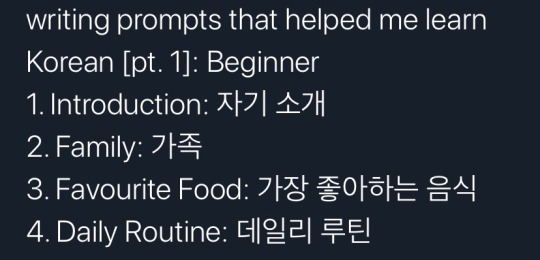
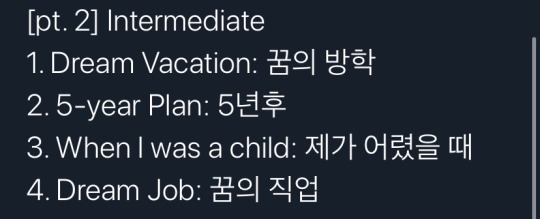
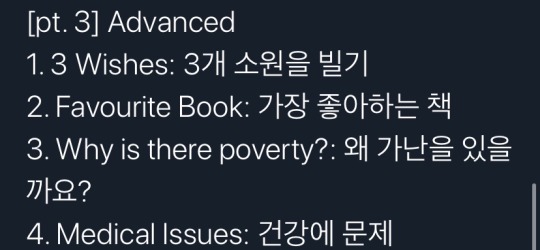
If you have more, reblog / comment your ideas so can add more to the list ~
Happy Learning :)
~ SK101
501 notes
·
View notes
Text
Hangul Lesson: Stroke Order
안녕하세요! Hey everyone! I have a long-overdue Hangul lesson – all about stroke order! While Korean stroke order is good to know, it’s not quite as imperative that you get the strokes right the same way that it might be for other languages like Chinese. That said, it can help your Korean handwriting look more natural, and knowing the correct order of strokes is actually really useful for reading people’s handwriting! I recommend watching this really interesting video by Go!Billy – in a nutshell, he says that knowing the stroke order is important because you’ll be able to essentially “trace” someone’s handwriting, so you’ll be able to read it even if it’s messy! Let’s get into it!
Some General Rules
Stroke order can seem a little overwhelming and even kind of random or arbitrary, so let’s talk about some general rules that influence stroke order!
I used sayjack.com as my source for this section, and that website has little gif-type things that show how each consonant is written, so check that out as well!
Left to Right: ex. When writing ㄱ, start from its left edge and make your way right.
Top to Bottom: ex. When writing ㅎ, start with the little stroke on the very top, then the longer stroke right below, and then the circle on the bottom.
Outside In: ex. When writing ㅋ, write a ㄱ to “frame” the stroke in the middle.
Here are some drawings of my own showing the strokes!





I hope these help y’all out! Again, stroke order isn’t the most important thing when learning Korean, so don’t worry if you find it too overwhelming! It’s just something that’s nice to know – I don’t really think any native speakers would come at you if you don’t get it perfect lol :)
If you want to practice writing and reading Korean with others, join my Discord chat here and my Tumblr chat here! Don’t forget to follow me on Instagram too!
Want to expand your Korean vocabulary and get closer to fluency? Get Drops Premium using my affiliate link!
If you would like to donate and support this blog and my studies, check out my Ko-Fi! Thank you for your generosity! See you next time! 다음에 봐요!
656 notes
·
View notes
Text
Korean Vocabulary: Weather

NOUNS
기후 = Climate
구름 = Cloud ☁️
가뭄 = Drought
안개 = Fog 🌫
산불 = Forest Fire 🔥
우박 = Hail 🌨
번개 = Lightning ⚡️
비 = Rain 🌧
무지개 = Rainbow 🌈
빗방울 = Raindrop 💧
하늘 = Sky
눈 = Snow 🌨
눈꽃 = Snowflake ❄️
폭풍 = Storm ⛈
태양/해 = Sun ☀️
천둥 = Thunder 🌩
뇌우 = Thunderstorm ⛈
토네이도 = Tornado 🌪
태풍 = Typhoon 🌪
우산 = Umbrella ☂️
날씨 = Weather
일기 예보 = Weather Forecast
바람 = Wind 💨
ADJECTIVES
밝다 = to be bright
쌀쌀하다 = to be chilly
맑다 = to be clear
흐리다 = to be cloudy
춥다 = to be cold
어둡다 = to be dark
건조하다 = to be dry
덥다 = to be hot
습하다 = to be humid
따뜻하다 = to be warm
VERBS
오다 = (lit.) to come
비가 오다 = to rain
눈이 오다 = to snow
내리다 = (lit.) to go/come down
비가 내리다 = to rain
눈이 내리다 = to snow
불다 = (lit.) to blow
바람이 불다 = (for the wind) to blow
치다 = (lit.) to hit
천둥이 치다 = to be thundering
걷히다 = to clear
안개가 걷히다 = for the fog to lift
구름이 걷히다 = for the clouds to clear
504 notes
·
View notes
Text
K-Drama Words and Phrases
애교 - Aegyo (Acting cute)
미쳤어 - Are you crazy
대박 - Awesome
남자친구 - Boyfriend
축하해 - Congratulations
짝사랑 - Crush, One-sided love
아빠 - Dad
울지 마 - Don’t cry
가지 마 - Don’t go
걱정하지 마 - Don’t worry
죽을래 - Do you want to die
첫사랑 - First love
친구 - Friend
여자친구 - Girlfriend
화이팅 - Good luck
생일 축하해 - Happy birthday
안녕하세요 - Hello
야 - Hey
안녕 - Hi, Bye
바보 - Idiot, Fool
좋아해 - I like you, I like it
사랑해 - I love you
행복해 - I’m happy
보고 싶어 - I miss you
미안해 - I’m sorry
헤어지자 - Let’s break up
밥먹자 - Let’s eat
가자 - Let’s go
사랑 - Love
삼각관계 - Love triangle
아저씨 - Middle-agged man
아줌마 - Middle-aged woman
엄마 - Mom
아니 - No
헐 - Oh my god
아이구 - Oh no
괜찮아 - Okay, Alright, I’m okay, Are you okay
그래 - Okay, Really
누나 - Older female (Boys)
언니 - Older female (Girls)
형 - Older male (Boys)
오빠 - Older male (Girls)
제발 - Please
약속 - Promise
진짜 - Really
잘자 - Sleep well, Good night
선생님 - Teacher
기다려 - Wait for me, Hang on
뭐 - What
어떡해 - What do I do, What to do
왜그래 - What’s wrong, Why are you being like this
어디 - Where
어디야 - Where are you
왜 - Why
응 - Yeah, Uh huh, Yes
네 - Yes
아싸 - Yes, Yay
동생 - Younger Sibling
4K notes
·
View notes
Photo

basic polite present tense - korean info from TTMIK 1.16
1K notes
·
View notes
Text
Vocabulary 감정
감정 - emotions
걱정 - anxiety, worry
그립다 - to be missed, to be longed for
기분 - feeling
기쁘다 - to be glad, to be happy
깜짝 - surprisingly, all of sudden
놀라다 - to be surprised, to be amazed
느끼다 - to feel
답답하다 - to be stuffy, to feel helpless
무섭다 - to be scary
부럽다 - to be envious
불안 - uneasiness, restlessness
사랑 - love
상쾌하다 - to be refreshing
섭섭하다 - to be sad, to be regretful
슬프다 - to be sad
신나다 - to be excited
심심하다 - to be bored (because of having too much time)
외롭다 - to be lonely
우울하다 - to be depressed
울다 - to cry
웃다 - to smile, to laugh
즐겁다 - to be enjoyable, to be cheerful
지루하다 - to be bored
창피하다 - to be embarrassed, to be ashamed
편안하다 - to be free from anxiety, to be at ease
행복 - happiness
화 - anger
1K notes
·
View notes
Text
Cooking Vocab Pt 3: Ingredients

*I tried to just use ingredients common in Korean cooking*
Sauces/Oils/Pastes
간장 | soy sauce
국간장 | soy sauce for soups
참기름 | sesame oil
들기름 | perilla oil
어유 | fish oil
액젓 | fish sauce
멸치 액젓 | anchovy sauce
미림 | rice wine
케첩 | ketchup
마요 | mayo
겨자/머스타드 | mustard
스리라차 | Sriracha
물엿 | corn syrup
된장 | doenjang(?)/bean paste
고추장 | gochujang/red pepper paste
쌈장 | ssamjang/idk it’s a dip for bbq
춘장 | chunjang/black bean paste
Seasonings
소금 | salt
후추 | pepper
설탕 | sugar
마늘 | garlic
생강 | ginger
볶은 참깨 | roasted sesame seeds
고춧가루/고추가루 | Korean red pepper flakes
~ 가루 | ~ powder (마늘 가루 garlic powder, 빵가루 bread crumbs, etc)
미역 | seaweed
김 | roasted seaweed placed on top of dishes or used with stuff like sushi or 김밥
마른 멸치 | dried anchovy
다시마 | kelp
Starches and Noodles
밀가루 | flour
감자전분 | potato starch
고구마 전분 | sweet potato starch
쌀 | (uncooked) rice
어묵 | fish cakes
떡 | ddeok/rice cakes
당명 | sweet potato starch noodles
메밀국수 | buckwheat noodles
올챙이국수 | corn flour noodles
칡국수 | buckwheat and kudzu noodles
천사채 | kelp (I think) noodles
밀국수 | wheat noodles
라면 | ramen
두부 | tofu
순두부 | soft tofu
*I’ll make a separate post for meats, fish, vegetables, and fruits*
1K notes
·
View notes
Text
♡ KOREAN PARTICLES : HOW TO SAY WITH.
In korean, ~과/와, ~랑/이랑 and ~하고 can all be used interchangeably to mean “and”!
1. ~과 is attached to words ending in a consonant ~와 is attached to words ending in a vowel
우리는 국수와 김치를 먹고 싶어요 We want to eat noodles and kimchi 우리 - we 국수 - noodles 김치 - kimchi 먹다 - to eat ~고 싶어요 - want 는 - subject marker 를 - object marker (here, 국수 and 김치 act as one object together)
저는 밥과 케이크을 팔아요 I sell rice and cake 저 - i, me 밥 - rice 케이크 - cake 팔다 - to sell
2. ~이랑 is attached to words ending in a consonant ~랑 is attached to words ending in a vowel
저는 책이랑 연필을 샀어요 I bought a book and a pencil 저 - i 책 - book 연필 - pencil 사다 - to buy ~ㅆ어요 - past tense
제 친구랑 영화를 봤어요 I was a movie with my friend 제 - my 친구 - friend 영화 - movie 보다 - to watch
~하고 is attached to words ending in a consonant AND a vowel
한결은 파리하고 뉴욕에 갈 가에요 Han Gyeol will go to Paris and New York 파리 - paris 뉴욕 - new york 에 - location marker 가다 - to go ~ㄹ 거에요 - future tense
2K notes
·
View notes
